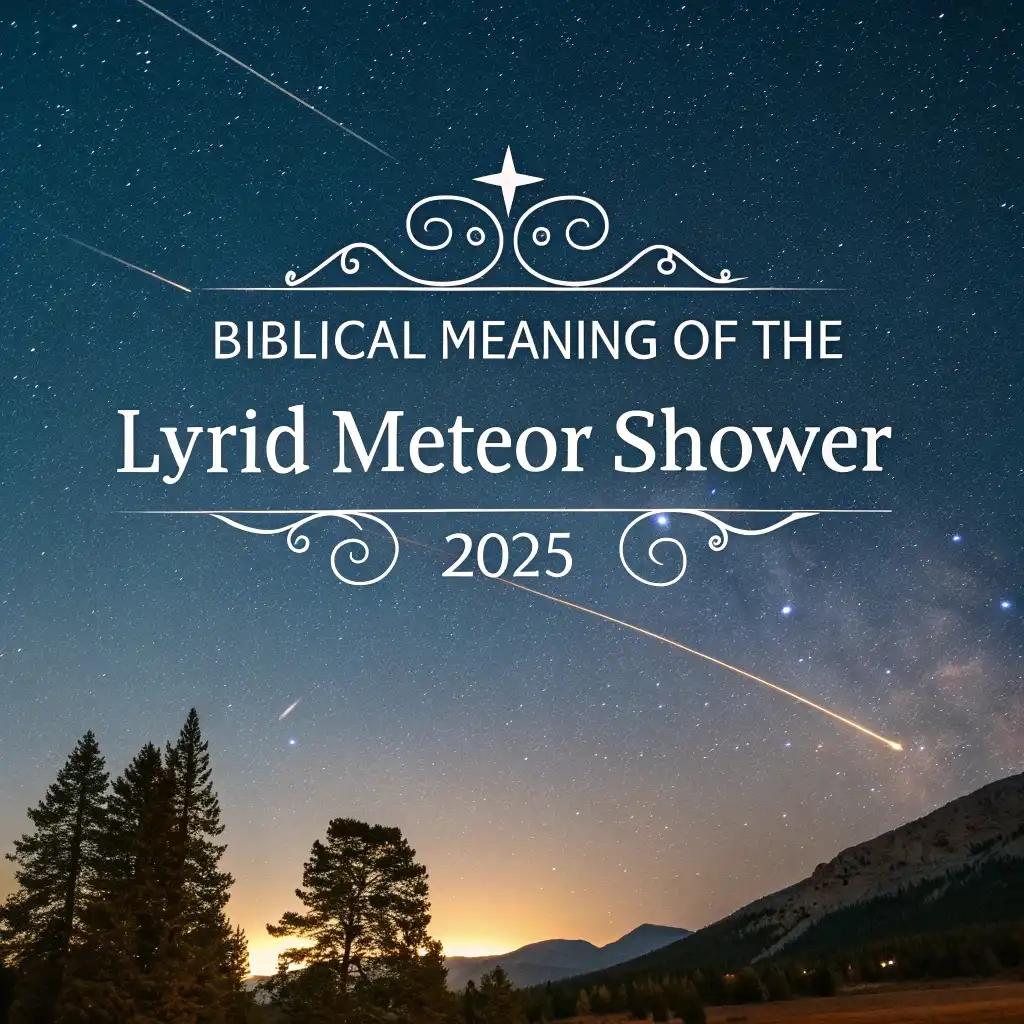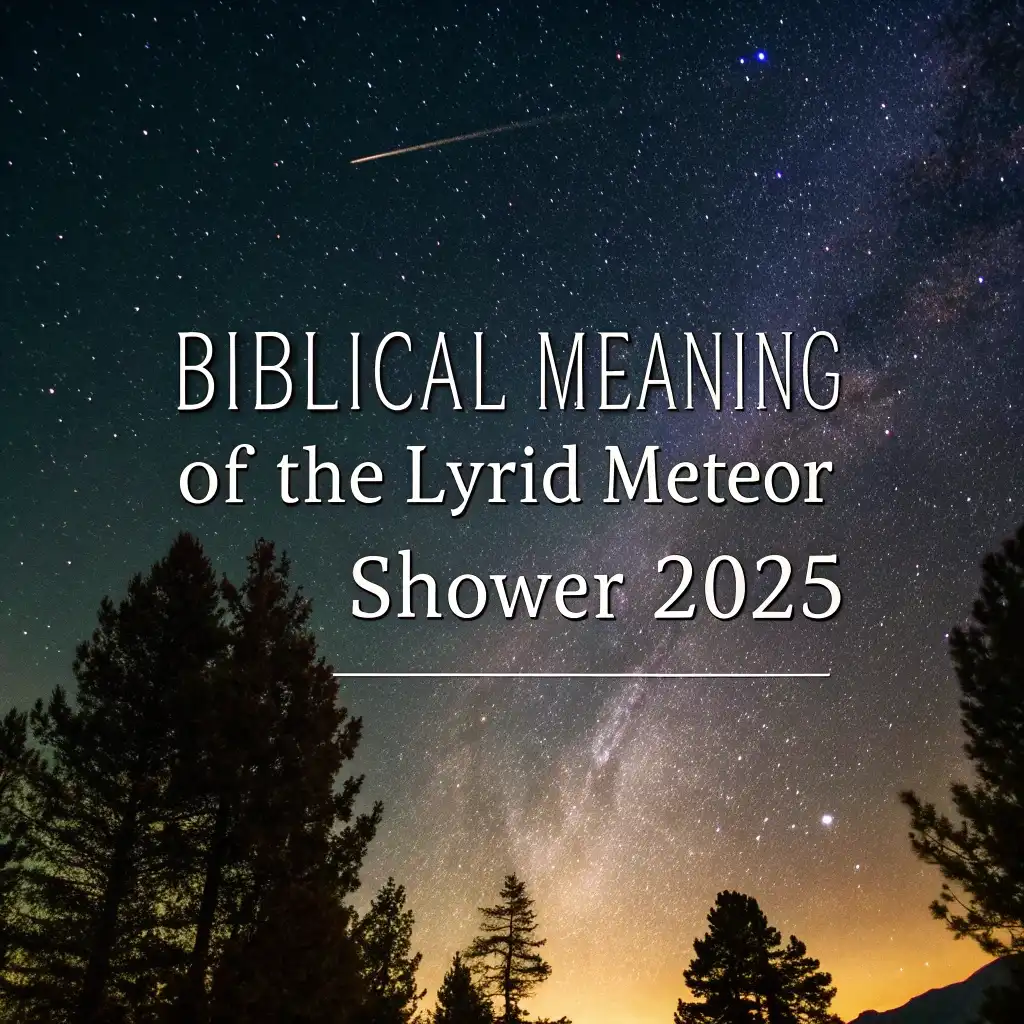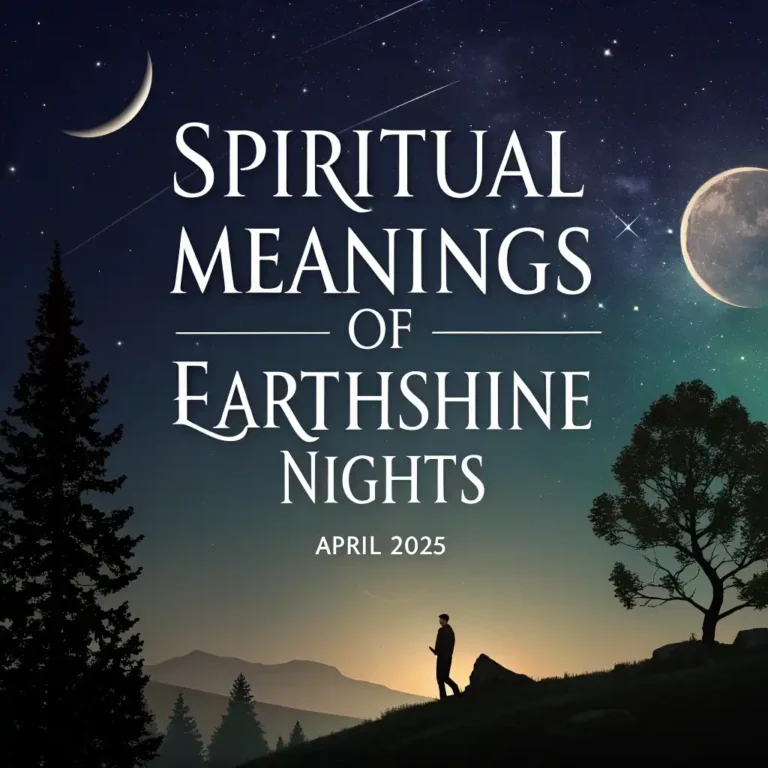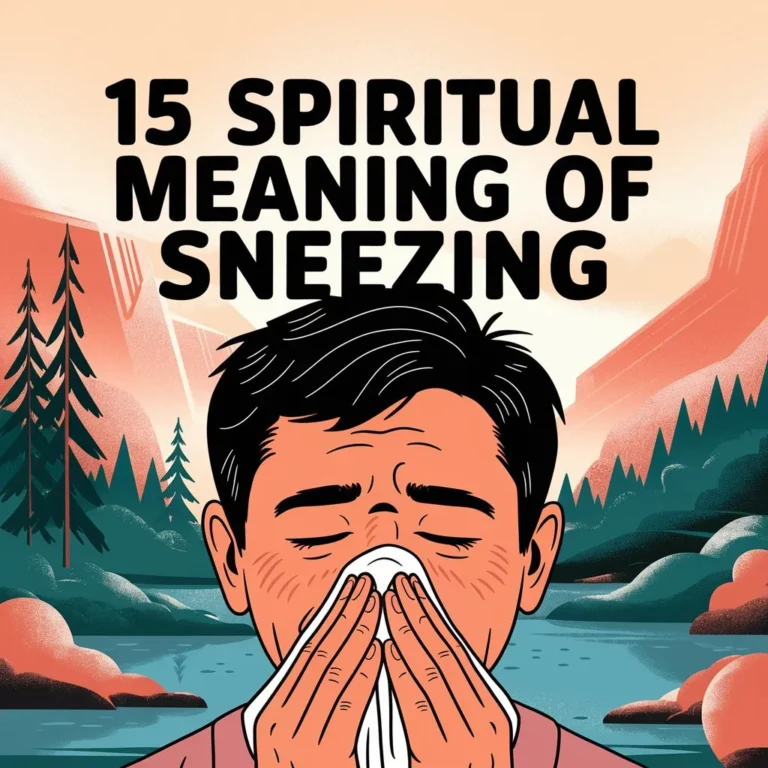Biblical Meaning of the Lyrid Meteor Shower 2025
Hey there! Have you ever looked up at the night sky and seen a meteor zip across it? That quick flash of light can feel like magic. Every year, we get to enjoy the Lyrid meteor shower, a special show of shooting stars.
In 2025, this event might carry extra meaning, especially if you love the Bible. What if those falling stars connect to something bigger, something spiritual?
Let’s dive into the Lyrid meteor shower and explore what it might mean through a biblical lens. Stick with me as we uncover the wonders of the sky and the messages it could hold for us in 2025. You won’t want to miss this!

Key Takeaways
Here’s a quick rundown of what you’ll find in this post. These points sum up the big ideas we’ll explore together.
- The Lyrid meteor shower happens every April. It peaks around April 22 to 23. In 2025, it promises a neat display of shooting stars.
- People have watched the Lyrids for thousands of years. Ancient records show it’s one of the oldest known showers. That’s pretty cool history!
- The Bible talks about the sky a lot. It mentions stars and heavens as signs from God. This gives us a way to think about meteor showers.
- Meteor showers don’t appear in the Bible directly. But we can link them to themes like God’s power and His messages to us.
- Watching the Lyrids can feel spiritual. It’s a chance to think about God’s creation and our place in it. The 2025 shower might inspire you deeply.
- You can see the Lyrids yourself. With simple tips, you’ll catch this event in April 2025. It’s an easy way to connect with the sky.
This list gives you a taste of what’s ahead. We’ll break down each point with fun facts and friendly thoughts. Let’s get started!
What Are Meteor Showers?
Meteor showers light up the night sky with streaks of brightness. They happen when Earth moves through dust and bits left by comets or asteroids. These tiny pieces, often as small as sand grains, hit our air and burn up. That’s what makes those glowing trails we call shooting stars.
The event starts when a comet passes near the Sun. The heat breaks off dust and rocks from the comet. Over time, this stuff spreads out along the comet’s path. When Earth crosses that path, we see a shower. Pretty neat, right?
Lots of showers happen each year. The Perseids come in August. The Geminids show up in December. Each one gets its name from the star group it seems to come from. For example, the Lyrids tie to the Lyra constellation.
People love watching these showers. They spark wonder and joy. You don’t need fancy gear, just a dark spot and some patience. In 2025, the Lyrid shower will give us another chance to enjoy this sky show. It’s a simple way to feel part of something huge. The Bible says the heavens show God’s glory (Psalm 19:1). Maybe meteor showers fit into that picture too!
All About the Lyrid Meteor Shower
The Lyrid meteor shower is a yearly treat for sky lovers. It comes from the constellation Lyra, near the bright star Vega. The shower happens because Earth passes through dust from Comet Thatcher. This comet swings by every 415 years or so, dropping bits that turn into meteors.
You can spot the Lyrids from April 16 to April 25. The best night is usually April 22 or 23. On a good night, you might see 10 to 20 meteors per hour. Sometimes, it gets wild with up to 100! That’s rare, but it happened in 1982 and way back in 1803.
The Lyrids have a long story. Chinese records from 687 BC talk about stars falling like rain. That’s over 2,700 years ago! This shower connects us to people from long ago. They looked up and felt the same awe we do.
In 2025, the Lyrids will peak around April 22 to 23. The moon will be a thin crescent, so the sky stays dark. That makes it easier to see those shooting stars. Grab a blanket and find a spot away from lights. You’ll love it!
The History of the Lyrids
The Lyrids have been around for ages. People first wrote about them in 687 BC in China. They saw tons of meteors and called it a rain of stars. Imagine how amazing that must have looked back then!
Other old cultures noticed meteors too. Greeks and Romans thought they were signs from gods. They didn’t know about comets, so they made up stories. The Lyrids probably caught their eyes, even if they didn’t name them.
Science changed things later. In 1861, an astronomer named A.E. Thatcher found the comet behind the Lyrids. That’s when we learned it’s not magic, just space dust. But the wonder didn’t go away. People still love the show.
Some Lyrid years stand out. In 1803, folks in Virginia saw hundreds of meteors per hour. Greece got a big display in 1922. These bursts keep the Lyrids exciting. In 2025, we might get lucky again. History shows this shower has surprises up its sleeve!
How Cultures See Meteor Showers
Meteor showers stir up all kinds of ideas. In old Greece, people thought meteors meant the gods were talking. A bright streak could be good or bad news. They’d pray or make offerings to figure it out.
Norse folks had a fun take. They said meteors were sparks from Thor’s hammer. In India, some believed shooting stars were souls heading to the afterlife. Every culture saw them their own way.
For Christians, meteors can feel like God’s handiwork. The Bible doesn’t list them, but it talks about sky signs. People might see a shower and think of God’s power or a call to look up. It’s a personal thing, full of meaning.
Today, we know the science. Meteors are just rocks burning up. Still, they keep that special vibe. The Lyrids in 2025 could make you wonder what folks long ago thought. It’s a bridge between us and them.
The Bible and the Sky
The Bible loves talking about the sky. It starts in Genesis 1:14 to 16. God makes lights to mark time and seasons. Stars, sun, and moon all have a job up there.
Psalm 19:1 says the heavens tell God’s glory. Every twinkling star points to Him. Psalm 8:3 to 4 adds to it. The writer looks at the sky and feels small but loved. The sky is God’s big show.
Stars mean more sometimes. In Revelation 1:20, they stand for angels. The star over Bethlehem led wise men to Jesus (Matthew 2:1 to 2). It’s like God uses the sky to send notes.
Prophecies bring up sky stuff too. Joel 2:30 to 31 mentions wild signs before God’s big day. The sun goes dark, and stars fall. It’s dramatic! The Lyrids might not be that, but they fit the idea of God’s sky speaking to us.
Bible Stories with Sky Signs
The Bible has cool sky moments. Take the star of Bethlehem. Matthew 2:1 to 2 says it guided wise men to Jesus. It was a big deal, showing God’s plan in action.
Then there’s Jesus’ death. Matthew 27:45 tells us the sun went dark for three hours. It matched the huge moment on the cross. The sky joined in to tell the story.
Prophecies get wilder. Revelation 6:12 to 13 paints a picture. The sun turns black, and stars drop like fruit in a storm. It’s a sign of big changes coming. These stories show the sky matters.
The Lyrids aren’t named in the Bible. But they’re part of that same sky. In 2025, watching them might remind you of these tales. God’s been using the heavens forever!
The Star of Bethlehem Up Close
Let’s zoom in on the star of Bethlehem. Matthew 2:1 to 12 says wise men followed it to Jesus. Was it a comet? A planet lineup? Some say it was pure miracle.
Whatever it was, it led them right to the Messiah. Numbers 24:17 ties in too. It promises a star from Jacob, hinting at a king. God picked a sky sign to shout the news.
This star shows how God uses the heavens. It wasn’t random. It had a purpose. The Lyrids in 2025 won’t lead to a baby king, but they can still point us to God’s amazing work up there.
I love thinking about those wise men. They saw something special and chased it. Maybe the Lyrids can spark that kind of wonder in us too.
Sky Signs in Bible Prophecies
Bible prophecies often mention the sky. Matthew 24:29 is a big one. Jesus says the sun and moon will dim, and stars will fall. It’s a heads-up for tough times ahead.
Joel 2:30 to 31 gets vivid. Blood, fire, and dark skies signal God’s day. Revelation adds falling stars too. People have watched the sky for these clues forever.
Some link meteors to this stuff. The Lyrids don’t match exactly, but they fit the vibe. They remind us to keep our eyes open. Jesus said to watch and pray (Luke 21:36). The 2025 shower could be a nudge to do that.
The Lyrid Shower in 2025
In 2025, the Lyrids peak on April 22 to 23. You’ll see 10 to 20 meteors per hour if the sky’s clear. Sometimes, it jumps higher. The moon will be a slim crescent, so it won’t wash out the view.
The radiant sits near Vega in Lyra. Look northeast before dawn. That’s when it’s best. Mark your calendar for a sky party! Weather and light pollution can affect it, so check forecasts.
This year’s shower feels special. It’s a chance to see history repeat. Bundle up, grab a friend, and enjoy the show. You might catch a big burst!
Lyrids and Bible Dates
The Bible uses a Hebrew calendar. April 22 to 23 in 2025 lands in Iyar. No big feasts happen then, but it’s part of counting the Omer. That’s a reflective time before Pentecost.
Linking the Lyrids to Bible dates is tricky. The calendars don’t match perfectly. Still, Iyar’s quiet vibe might fit a night of stargazing. It’s a personal chance to think about God.
The shower’s timing isn’t a Bible event. But it can still feel meaningful. Use it to pray or ponder under the stars.
What Could the 2025 Lyrids Mean?
The Bible doesn’t name meteor showers. Still, we can guess at meanings. Genesis 1:14 says sky lights mark seasons. The Lyrids could remind us of God’s order.
Psalm 19:1 calls the sky a glory show. Watching meteors might make you praise Him. They’re quick, like life. That can push us to live well.
Some see sky signs as warnings. The Lyrids in 2025 might feel like a wake-up call. It’s up to you what they mean. I think they’re a cool nudge to look at God’s work.
How to Watch the 2025 Lyrids
Want to see the Lyrids? Go somewhere dark on April 22 to 23. Cities hide the stars, so head out of town. Before dawn is prime time.
Bring a blanket or chair. Lie back and look up. Give your eyes 30 minutes to adjust. Face northeast toward Lyra, but scan everywhere. Patience pays off with meteors.
No telescope needed. Just you and the sky. Bring a snack and enjoy. It’s a simple way to catch the 2025 show!
Spiritual Thoughts from the Sky
Stargazing feels special. The sky’s so big, and we’re so small. Psalm 147:4 says God names every star. That blows my mind!
Meteors add a twist. They flash and fade fast. It’s like a lesson to grab the moment. The Lyrids can lift your spirit. They pull you closer to God’s creation.
In 2025, take time to watch. Think about your life under that huge sky. It’s a quiet way to feel connected.
My Take on Meteors and Faith
I’ve seen a few showers myself. Once, during the Perseids, I lay out and saw dozens of streaks. Each one felt like God saying, “Hey, I’m here!”
The Lyrids in 2025 will be like that for me. Science explains them, but faith adds heart. They mix wonder and belief. What do you think? Ever felt that spark under the stars?
FAQs
How Do I Best See the Lyrid Meteor Shower?
Go to a dark spot away from lights. Watch before dawn on April 22 to 23, 2025. Lie back and wait. Your eyes need time to adjust.
Does the Bible Talk About Meteor Showers?
No, it doesn’t list them. It does mention sky signs and stars. You can connect the dots yourself.
Are Meteor Showers God’s Signs?
Maybe! Some think so. The Bible says to watch the sky. Decide what feels true to you.

Sofia Phillips is a renowned spirituality expert and the visionary behind SoulfulCreature.com. With a compassionate heart and an enlightened mind, Sofia embarks on a quest to guide others through the realms of spirituality. Her approach is deeply rooted in providing a nurturing and positive experience, allowing individuals to explore and grow in their spiritual journey.







